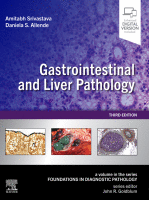Physical Address
304 North Cardinal St.
Dorchester Center, MA 02124

You’re Reading a Preview Become a Clinical Tree membership for Full access and enjoy Unlimited articles Become membership If you are a member. Log in here

Liver Transplantation Liver transplantation is performed in patients with liver failure caused by acute or chronic liver disease, selected hepatic tumors, and some metabolic diseases. Approximately 7000 liver transplants (LT) are performed annually in the United States. The graft survival…

The gastrointestinal (GI) tract is the most common site of extranodal lymphoma, which should not be a surprise as the GI system contains approximately 70% of the lymphoid tissue and 80% of the plasma cells (most of those being immunoglobulin…

Primary hepatocellular neoplasms are much less common than metastatic tumors to the liver. The former may arise from either the epithelial or mesenchymal component of the hepatic parenchyma and rarely may also show both lines of differentiation. Hepatocellular neoplasms may…

Major Histologic Patterns of Injury Because the liver presents with a relatively small repertoire of responses to injury, there is significant histologic overlap among liver diseases, making specific diagnosis challenging. A pattern-based approach enables the pathologist to generate a relatively…

Non-Neoplastic Diseases Developmental Anomalies The three most commonly encountered developmental anomalies of the pancreas in routine surgical pathology practice are pancreas divisum, annular pancreas, and ectopic pancreas. Pancreas Divisum Pancreas divisum occurs in 3% to 7% of the population as…

The gallbladder and extrahepatic bile ducts show a limited spectrum of inflammatory and neoplastic disorders, but these disorders are significant because they affect a large proportion of the world’s population. The most common (>95%) is cholelithiasis. Inflammation in the gallbladder…

Anal Anatomic and Histologic Landmarks The anal canal encompasses the distal most 3 to 4 cm of the most distal intestinal tract. It is defined proximally by the palpable upper border of the internal sphincter muscle, which is a continuation…

Molecular testing of colorectal carcinomaAlthough there are numerous esoteric tests that a molecular pathology laboratory may use on colorectal cancer (CRC) specimens, there are two tests that are the most common and important—assessment of mismatch repair (MMR) integrity and RAS/RAF…

A large variety of neoplasms may occur in the colorectum, reflecting the complexity of this organ and its cellular components. This chapter focuses primarily on those neoplasms arising from the epithelial and neuroendocrine cells of the colorectum. Epithelial neoplasms that…